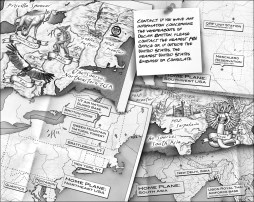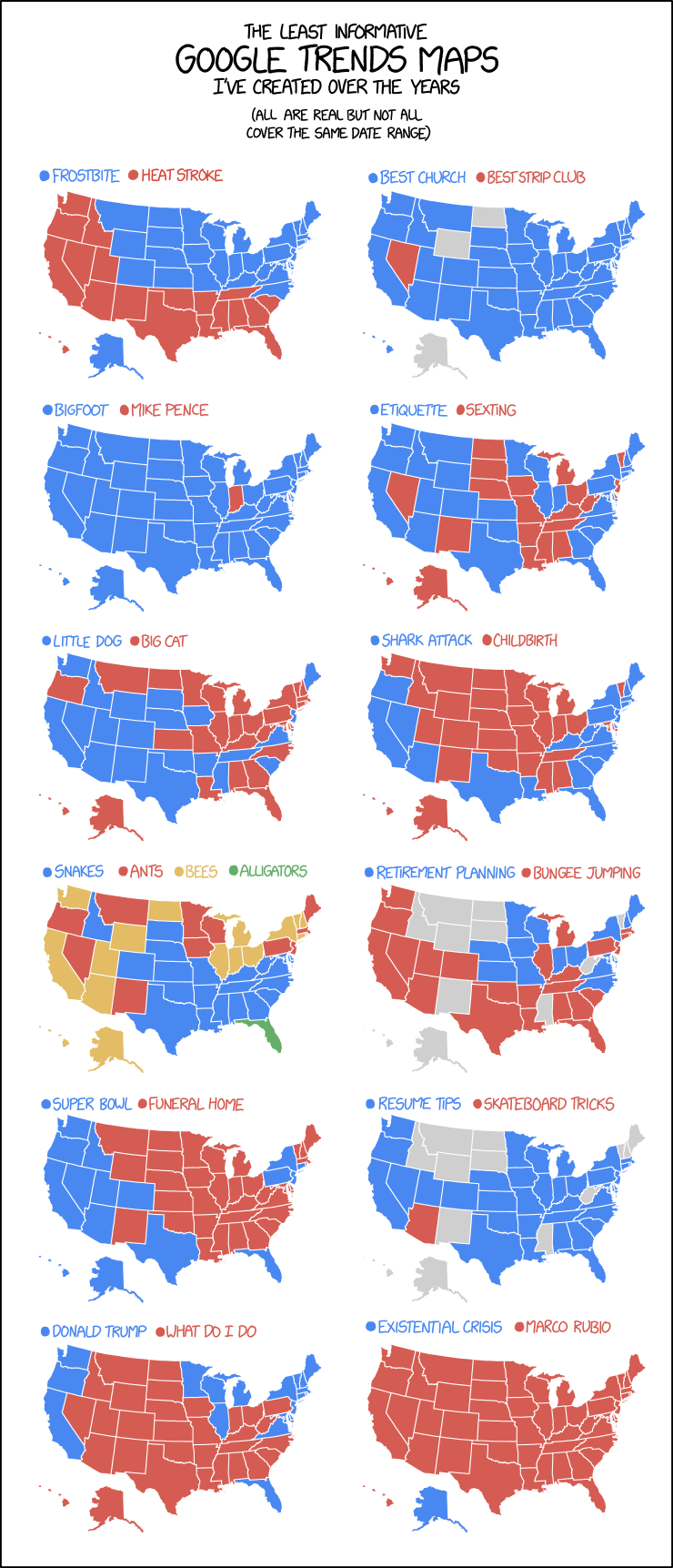The Atlantic maps political polarization in America. “The result was surprising in several ways. First, while virtually all Americans have been exposed to hyper-partisan politicians, social-media echo chambers, and clickbait headlines, we found significant variations in Americans’ political ill will from place to place, regardless of party.” Includes an interactive map with county-level data based on polling and analytics.
Search Results for Forgotten Towns
Online maps are giving ghost towns a new life, of sorts. The Daily Southtown’s Ted Slowik looks at the case of Gilletts, Illinois, a forgotten milk stop on the Rock Island line. But thanks to its listing in the USGS’s Geographic Names Information System and the fact that it’s surrounded on all sides by medium-sized cities and towns, doing a search on Gilletts generates all kinds of results.
Shopping for a new home? A search on Zillow produces 12 results of homes for sale near Gilletts. Trulia, another real estate website, generates 84 results.
Searching for a job? The website Indeed shows 718 employment opportunities within 5 miles of Gilletts. Another site, Simply Hired, shows 563 jobs available within 5 miles of Gilletts.
You can find Gilletts on Mapquest. You can get the forecast for Gilletts on AccuWeather’s website. If you’re looking for a hotel room, Booking.com can show you more than 70 rooms available and their distance in miles from downtown Gilletts.
Except there is no downtown Gilletts, since it was never anything more than a depot where trains stopped to pick up milk that local farmers sold to markets in Chicago and elsewhere.
But according to Yelp, there are 115 places to eat, 233 things to do and 353 places to shop within striking distance of Gilletts.
The same is no doubt true with any named point on the map, and to be honest this is probably how it should be. Web services are providing results based on proximity to a given location: there’s no judgment about the significance of that location. You’re the one who put the ghost town’s name into the search engine: here you go.
An Exhibition of Historic Maps of New York City: New Amsterdam to Metropolis
Untapped Cities has photos from an exhibition of historic and antique maps of New York City at the gallery of Manhattan rare book dealer Martayan Lan. New Amsterdam to Metropolis: Historic Maps of New York City features maps of the city dating back to the 16th century. It opened last November and runs until the end of May 2019. Some (but not all) of the maps, the New York Times notes, are for sale, which is what happens when it’s a rare book dealer rather than a museum or library doing the exhibition.
xckd’s ‘Least Informative’ Google Trends Maps
Oh look, another map-themed comic/infographic thingy from xkcd: the March 20 edition is having some fun with the maps generated by Google Trends data. The maps are real, says Randall.
Priscilla Spencer, Fantasy Mapmaker



I’m impressed by the work of fantasy mapmaker Priscilla Spencer, whose maps have illustrated novels by Seanan McGuire, Myke Cole, Jim Butcher and Saladin Ahmed, among others. Spencer’s maps push the boundaries of the default fantasy map style: some of them appear as they would in-universe, others adopt elements appropriate to the culture of the world being mapped. Making a note for future reference.
A Map of Modern-Day Westeros
Art designer James Shadrach Schoenke imagines a modern-day Westeros with a modern-style map that mimics the design of European road maps.
Using Street View to Spot Gentrification
CBC News: “A group of researchers at the University of Ottawa is using Google Street View to spot instances of gentrification in the city’s neighbourhoods. […] The program looks for patterns of improvements on individual properties, such as new fences, landscaping, siding or significant renovations.” Honestly not something for which I expected Street View to have a use.
What Does a Fantasy Map Look Like?
New from me on Tor.com this morning: “What Does a Fantasy Map Look Like?” This is the first of several planned pieces that will take a deep dive into the look and feel of fantasy maps: their design and aesthetic, their origins and inspirations, and where they may be going in the future. In this piece, I start by trying to describe a baseline fantasy map style—which, though it’s well recognized and often imitated, has not often been spelled out.
AM New York on the NYPL Map Division
Meanwhile, AM New York takes a look at the holdings of the New York Public Library’s Map Division.
Osher Map Library TV Segment
News Center Maine, the news wing of Portland, Maine NBC affiliate WCSH, has a segment profiling the Osher Map Library.
‘Last Week Tonight’ Solves the Missing New Zealand Problem
 On Last Week Tonight’s 17 February episode, host John Oliver took a moment to look at how New Zealand keeps getting left off world maps—the case of IKEA’s map poster being the most recent example. They are nothing if not helpful: as a solution, the show’s Twitter account has posted a cutout map of New Zealand to print and paste on any map that has left it off.
On Last Week Tonight’s 17 February episode, host John Oliver took a moment to look at how New Zealand keeps getting left off world maps—the case of IKEA’s map poster being the most recent example. They are nothing if not helpful: as a solution, the show’s Twitter account has posted a cutout map of New Zealand to print and paste on any map that has left it off.
IKEA’s going to need extra security.
New Zealand media is all over this: New Zealand Herald, RNZ, TVNZ.
Previously: IKEA Map Poster Omits New Zealand; New Zealand Launches Campaign to Get Itself Back on World Maps; Maps Without New Zealand.
Satellite Mode, Aerial Mode, Bird Mode
Here’s a silly Google Maps origin story about how “Satellite” was almost named “Bird Mode” pic.twitter.com/wj7CRJUEyx
— Bret Taylor (@btaylor) February 23, 2019
A lot of what we refer to on online maps as “satellite imagery” actually isn’t: the high-resolution stuff is usually taken from airplanes. This can be a point of confusion for some—and, according to this Twitter thread from Google Maps co-creator Bret Taylor, also a point of contention for the Google Maps team before it launched. Some engineers felt that calling the layer “Satellite” was factually incorrect—because of that aerial imagery—and therefore shouldn’t be used; others argued for “Satellite” based on label size and usability studies. It nearly got called “Bird Mode” as a compromise. [Boing Boing]
Festival of Personal Geographies
The Festival of Personal Geographies explores the use of art in creating personalized maps. Running until March 19 at several venues in Ames, Iowa, the Festival consists of an exhibition (“‘Index to a Place,’ an exhibition of prints, drawings and paintings that use the graphical languages of maps as a starting point in their creation”) and four workshops on personalized mapmaking. The event is organized by local artist Tibi Chelcea and hosted by ISU’s Design on Main Gallery. Free admission, free registration.
Previously: Personal Geographies; Art and Personal Mapmaking.
The Minimal Geography Atlas
Our friend Alejandro Polanco’s latest project is The Minimal Geography Atlas, a collection of 40 thematic maps.
In my work as a map designer and science writer, I have collected over the past two decades hundreds of curious stories related to cartography or geography. These stories have seen the light of day in the form of hundreds of articles in magazines and blogs, as well as in posters or maps of very diverse types. Now, I’ve decided to compile my best maps and lesser-known but interesting curiosities from all that material I’ve collected over the years. The result is this book, an atlas designed to awaken your curiosity. The thematic maps that I have selected are part of the ones that I have created in the last years, improving them and adapting them for this book.
Alejandro is currently running a Kickstarter for the book. €18 gets you the digital edition, €65 the print edition (in softcover).
Previously: Alejandro Polanco’s Minimal Geography; Alejandro Polanco’s Lost Worlds.
Opportunity’s Path
Don’t miss the New York Times’s scrollable map of the path of the Opportunity rover on Mars. (From a technical standpoint it functions much like their map of the U.S.-Mexico border.)





